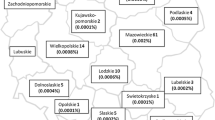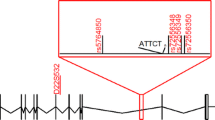Abstract
This study addresses the question whether the different forms of autosomal dominant cerebellar ataxia (ADCA) are related to different ethnic/geographical regions in Europe. One mutation in families originating from Holland, Prussia and Italy has previously been localized to chromosome 6p (SCA1 locus), whereas the mutation in families of Iberic origin has been excluded from chromosome 6p. In a Danish five-generation pedigree with ADCA and in which previous HLA-serotyping had shown inconclusive linkage results, the present study shows unequivocal exclusion from the SCA1 locus, firstly through the use of the new, highly informative microsatellites D6S89 and D6S109, which closely flank the SCA1 locus, and secondly through the manifestation of disease in four pedigree members previously scored as unaffected. Additional molecular genetic analysis of the HLA DRbeta and F13A polymorphisms also argue against a cluster of ADCA genes on chromosome 6p. Since this study demonstrates the existence of non-SCA1 families and therefore heterogeneity in the North-European population, molecular family counselling remains restricted to the few known SCA1 families.
Similar content being viewed by others
References
Auburger G, Orozco G, Ferreira R, Gispert S, et al (1990) Autosomal dominant ataxia: genetic evidence for locus heterogeneity from a Cuban founder effect population. Am J Hum Genet 46:1163–1177
Coutinho P, Andrade C (1978) Autosomal dominant system degeneration in Portuguese families of the Azores islands: a new genetic disorder involving cerebellar, pyramidal, extrapyramidal and spinal cord motor functions. Neurology 28:703–709
Frontali M, Iodice C, Lulli P, Spadaro M, Capellacci S, Giunti P, Malaspina P, Morellini M, Morocutti C, Novelletto A, Persichetti F, Trabace S, Anastasi R, Terrenato L (1991) Spinocerebellar ataxia (SCA1) in two large Italian kindres: evidence in favour of a locus position distal to GLO1 and the HLA cluster. Ann Hum Genet 55:7–15
Haines JL, Schut LJ, Weitkamp LR, Thayer M, Anderson VE (1984) Spinocerebellar ataxia in a large kindred: age at onset, reproduction, and genetic linkage studies. Neurology 34:1542–1548
Harding AE (1982) The clinical features and classification of the late onset autosomal dominant cerebellar ataxias. Brain 105:1–28
Jackson JF, Currier RD, Terasaki PI, et al. (1977) Spinocerebellar ataxia and HLA linkage. N Engl J Med 296:1138–1141
Keats BJB, Pollack MS, McCall A, Wilensky MA, Ward L, Lu M, Zoghbi HY (1991) Tight linkage of the gene for Spinocerebellar ataxia to D6S89 on the short arm of chromosome 6 in a kindred for which close linkage to both HLA and F13A1 is excluded. Am J Hum Genet 49:972–977
Konigsmark BW, Weiner LP (1970) The olivopontocerebellar atrophies: a review. Medicine (Baltimore) 49:227–241
Lathrop GM, Lalouel JM, Julier C, Ott J (1984) Strategies for multilocus linkage analysis in humans. Proc Natl Acad Sci USA 81: 3443–3446
Litt M, Luty JA (1990) Dinucleotide repeat polymorphism at the D6S89 locus. Nucleic Acids Res 18:4301
Myers SM, MacLeod PM, Forse RA, Forster-Gibson CJ, Simpson NE (1986) Machado Joseph disease: linkage analysis between the loci for the disease and 18 protein markers. Cytogenet Cell Genet 43:226–228
Nino HE, Noreen HJ, Dubey DP, Resch JA, Namboodiri K, Elston RC, Yunis EJ (1980) A family with hereditary ataxia: HLA typing. Neurology 30:12–20
Orozco G, Nodarse A, Cordoves R, Auburger G (1990) Autosomal dominant cerebellar ataxia: clinical analysis of 263 patients from a homogeneous population in Holguin. Cuba. Neurology 40:1369–1375
Ott J (1979) Genetic linkage studies in man. Transplant Proc 11: 1689–1691
Pedersen L (1980) Hereditary ataxia in a large Danish pedigree. Clin Genet 17:385–393
Pedersen L, Platz P, Ryder L, Lamm LU, Dissing J (1980) A linkage study of hereditary ataxias and related disorders. Hum Genet 54:371–383
Ranum LP, Duvick LA, Rich SS, Schut LJ, Litt M, Orr HT (1991a) Localization of the autosomal dominant HLA-linked spinocerebellar ataxia (SCA) 1 locus, in two kindreds, within a 8-cM subregion of chromosome 6p. Am J Hum Genet 49: 31–41
Ranum LPW, Chung MY, Duvick LA, Zoghbi H Y, Orr H (1991b) Dinucleotide repeat polymorphism at the D6S109 locus. Nucleic Acids Res 19:1171
Ranum LPW, Rich SS, Nance MA, Duvick LA, Aita JF, Orr HT, Anton-Johnson S, Schut LJ (1992) Autosomal dominant spinocerebellar ataxia: locus heterogeneity in a Nebraska kindred. Neurology 42:344–347
Saiki RK, Bugawan TL, Horn GT, Mullis KB, Erlich HA (1986) Analysis of enzymatically amplified beta-globin and HLADQalpha DNA with allele-specific oligonucleotide probe. Nature 324:163–166
Schut JW (1950) Hereditary ataxia: a clinical study through six generations. Arch Neurol Psychiatry 63:535–568
Vaughan RW, Lanchbury JSS, Marsh SGE, Hall MA, Bodmer JG, Welsh KI (1990) The application of oligonucleotide probes to HLA-class II typing of the DRB sub-region. Hum Immunol 36:149–155
Werdelin L, Platz P, Lamm LU (1984) Linkage between late onset, dominant spinocerebellar ataxia and HLA. Hum Genet 66:85–89
Zoghbi HY, Daiger SP, McCall A, O'Brien WE, Beaudet A (1988) Extensive DNA polymorphism at the factor XIIIa (F13A) locus and linkage to HLA. Am J Hum Genet 42:877–883
Author information
Authors and Affiliations
Rights and permissions
About this article
Cite this article
Lunkes, A., Gispert, S., Enczmann, J. et al. Molecular heterogeneity of autosomal dominant cerebellar ataxia: analysis of flanking microsatellites of the spinocerebellar ataxia 1 locus in a northern European family unequivocally demonstrates non-linkage. Hum Genet 91, 362–366 (1993). https://doi.org/10.1007/BF00217357
Received:
Revised:
Issue Date:
DOI: https://doi.org/10.1007/BF00217357




